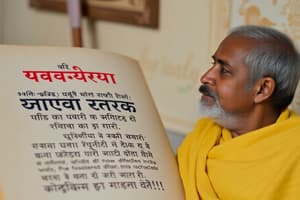Podcast
Questions and Answers
During which century did the modern Marathi language begin to take shape?
During which century did the modern Marathi language begin to take shape?
- 7th century CE
- 2nd century CE
- 11th century (correct)
- 15th century
Which dynasty played a key role in promoting the use of Marathi in their inscriptions?
Which dynasty played a key role in promoting the use of Marathi in their inscriptions?
- Maurya Empire
- Mughal Empire
- Gupta Empire
- Shilahara dynasty (correct)
Under whose rule did Marathi gain significant importance and its standardized form was established?
Under whose rule did Marathi gain significant importance and its standardized form was established?
- Aurangzeb
- Shivaji and Chhatrapati Shivaji Maharaj (correct)
- Harsha Vardhana
- Akbar the Great
Which script is used to write Marathi?
Which script is used to write Marathi?
What is Marathi known for in terms of its grammar?
What is Marathi known for in terms of its grammar?
Who authored the 13th-century Marathi text Prabodhan?
Who authored the 13th-century Marathi text Prabodhan?
Who wrote the epic poem 'Gajanan Maharaj'?
Who wrote the epic poem 'Gajanan Maharaj'?
Which literary work is considered among the first literary texts of the Marathi language?
Which literary work is considered among the first literary texts of the Marathi language?
Who is attributed with the ancient text on Indian theatre, the Natyashastra?
Who is attributed with the ancient text on Indian theatre, the Natyashastra?
Which playwright is known for pioneering modern Marathi theatre?
Which playwright is known for pioneering modern Marathi theatre?
Who is known for writing the 19th-century commentary on the Bhagavad Gita, 'Gita Rahasya'?
Who is known for writing the 19th-century commentary on the Bhagavad Gita, 'Gita Rahasya'?
'Gulabdasa' by V.S. Khandekar is considered a milestone in which type of literature?
'Gulabdasa' by V.S. Khandekar is considered a milestone in which type of literature?
Study Notes
Marathi Language and Literature
The Marathi language, originating in Maharashtra in Western India, is a part of the Indo-Aryan family of languages and is the second-most widely spoken language in India, after Hindi. With its rich history and cultural significance, Marathi has played a pivotal role in shaping the region's literature, arts, and society.
The Marathi Language
Marathi's ancient roots can be traced back to the 2nd century CE, when it was primarily used in Maharashtra's Buddhist literature. However, the modern Marathi language began to take shape during the 11th century, with the emergence of the Shilahara dynasty, which promoted the use of Marathi in their inscriptions. It was during the reign of the Maratha Empire (1674-1818), especially under the rule of Shivaji and Chhatrapati Shivaji Maharaj, that the language gained significant importance and its standardized form was established.
Marathi, written using the Devanagari script, has a rich lexicon, drawing from a variety of sources including Sanskrit, Prakrit, and local dialects. The language is renowned for its flexible grammar and is known for its use of suffixes to convey different tenses, moods, and aspects.
Marathi Literature
Marathi literature has a long and illustrious history, dating back to the 13th century. Some of the earliest examples of Marathi writings include the 13th-century Prabodhan by Nila Ghanave, a didactic text that encouraged the use of Marathi in place of Sanskrit.
The 19th century saw the birth of the Marathi literary renaissance, with the works of poets like Keshavasut, Lokmanya Tilak, and Mahadev Govind Ranade. Literary societies such as the Maharashtra Sahitya Sammelan and Natyasamaj played a pivotal role in promoting Marathi as a literary language.
Some of the most celebrated Marathi literary works include:
- Kirti Nakh by Mukundraj: This is considered among the first literary texts of the Marathi language, written in the 14th century.
- Annadata Mahima by Eknath: Written in the 16th century, this epic poem glorifies the virtues of a devoted wife.
- Gita Rahasya by Nana Phadnis: A 19th-century commentary on the Bhagavad Gita, this text is considered a masterpiece of Marathi prose.
- Gajanan Maharaj by Lokmanya Tilak: This epic poem, published in 1895, is an ode to the Hindu saint Gajanan Maharaj.
- Gulabdasa by V. S. Khandekar: This modern-day epic, published in 1961, is considered a milestone in Marathi literature.
Marathi literature is also known for its rich tradition of theatre and drama. The Natyashastra, an ancient text on Indian theatre, is attributed to Sage Bharata – a Maharashtrian. Modern Marathi theatre, pioneered by playwrights like Vijay Tendulkar and Mahesh Elkunchwar, has won numerous accolades and has had a significant impact on the Indian and global theater scene.
Marathi literature continues to flourish today, with a wide range of genres, including poetry, prose, drama, and non-fiction. The language has also seen the emergence of several noted female writers, such as Taramati Gadge, Indumati Patil, and Amrita Pritam.
In conclusion, Marathi language and literature have a rich history, extending from ancient texts to the modern era. With a diverse and flexible language and a vibrant literary tradition, Marathi has made an indelible mark on Indian culture, arts, and society.
Studying That Suits You
Use AI to generate personalized quizzes and flashcards to suit your learning preferences.
Description
Test your knowledge on the rich history and cultural significance of the Marathi language and literature, covering ancient roots, modern developments, renowned literary works, and notable playwrights. Explore the evolution of Marathi as a literary language and its impact on Indian culture.




